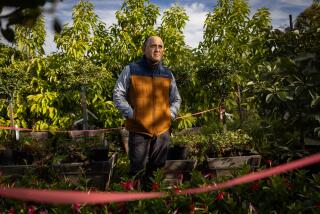Airlifted Wasps Fight Africa Crop Killers
- Share via
IBADAN, Nigeria — Predatory wasps dropped from low-flying aircraft are spearheading a scientific war on crop killers and other pests in Africa.
Scientists say the wasps have scored initial successes against a mealybug scourge that at one time threatened to destroy wide swathes of cassava fields across the continent.
Spurred by this success, scientists are now looking at similar biological methods to curb other pests, such as locusts, which play a major role in making famine a byword in much of Africa.
This approach to protecting and boosting food production was masterminded at the International Institute of Tropical Agriculture near the Nigerian city of Ibadan.
A major gain in using insects like wasps is elimination of the need for expensive and environmentally damaging chemicals.
“Wasps dropped by aircraft are killing insects in the world’s largest biological control program of its kind,” said David Osiru, a Ugandan scientist with the agriculture institute.
Institute officials say the program is being conducted in 24 sub-Saharan countries covering about one million square miles in a broad belt from East to West Africa.
The International Institute of Tropical Agriculture is a nonprofit body backed by Western donors, including the World Bank, which has hailed the wasp program as a remarkable technical and economic success.
High on the institute’s list of prospective projects is the use of insects to save maize in savanna areas from a killer weed. Maize and cassava, often grown by peasant farmers scratching livings from poor soil, are both African staples.
The institute has already succeeded in saving them from previous threats of devastation by producing disease-resistant strains.
Widespread use of wasps to save cassava, a tuberous root used to make bread, began in the early 1980s after mealybugs devastated up to 80% of some crops. Total annual losses were estimated at $2 billion.
The mealybug was first discovered in Zaire in 1973, together with the cassava green spider mite, and spread rapidly through a belt across Africa from Mozambique on the southeastern coast to Senegal and Guinea-Bissau on the western tip.
Scientists say the epidinocarsis lopezi wasp was selected as the mealybugs’ messenger of death after extensive research. The tiny wasp kills by laying eggs in the bodies of the bugs.
They point out, however, that more needs to be done to distribute the wasps and to control the green spider mite before final victory for cassava can be declared.
But there is delight at the progress made so far at the institute, which operates a 2,500-acre tract of test farmland worked by scientists from around the world.
“In our center for biological control in Cotonou, Benin, we are extending research to other pests, such as locusts, grasshoppers, the larger grain borer and weeds,” the institute said in a report.
The institute is looking at weevils as possible saviors of maize crops in savanna areas that are being killed by the parasitic striga weed, also known as witchweed.
“We are trying to build a resistant plant in our program, but other programs here are working on rotation crops and biological controls, such as weevils, which will bore into the flowers,” said Mark Wilson, an American research director at the institute.
“It is going to take a five- to 10-year program to overcome the thing. In another 10 years striga could be doing very major damage,” Wilson said in an interview.
Wilson said it was not clear how witchweed kills kill but said the weed appears to suck liquid from plant stalks and at the same time inject a toxin.
More to Read
Sign up for Essential California
The most important California stories and recommendations in your inbox every morning.
You may occasionally receive promotional content from the Los Angeles Times.













